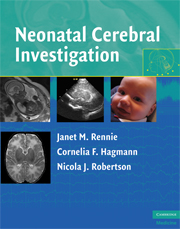Book contents
- Frontmatter
- Contents
- List of contributors
- Preface
- Acknowledgements
- Glossary and abbreviations
- Section I Physics, safety, and patient handling
- Section II Normal appearances
- Section III Solving clinical problems and interpretation of test results
- 7 The baby with a suspected seizure
- 8 The baby who was depressed at birth
- 9 The baby who had an ultrasound as part of a preterm screening protocol
- 10 Common maternal and neonatal conditions that may lead to neonatal brain imaging abnormalities
- 11 The baby with an enlarging head or ventriculomegaly
- 12 The baby with an abnormal antenatal scan: congenital malformations
- 13 The baby with a suspected infection
- 14 Postmortem imaging
- Index
- References
12 - The baby with an abnormal antenatal scan: congenital malformations
from Section III - Solving clinical problems and interpretation of test results
Published online by Cambridge University Press: 07 December 2009
- Frontmatter
- Contents
- List of contributors
- Preface
- Acknowledgements
- Glossary and abbreviations
- Section I Physics, safety, and patient handling
- Section II Normal appearances
- Section III Solving clinical problems and interpretation of test results
- 7 The baby with a suspected seizure
- 8 The baby who was depressed at birth
- 9 The baby who had an ultrasound as part of a preterm screening protocol
- 10 Common maternal and neonatal conditions that may lead to neonatal brain imaging abnormalities
- 11 The baby with an enlarging head or ventriculomegaly
- 12 The baby with an abnormal antenatal scan: congenital malformations
- 13 The baby with a suspected infection
- 14 Postmortem imaging
- Index
- References
Summary
Introduction – clinical presentation
Increasingly, neonatologists are asked to advise women whose fetus is thought to have a congenital malformation of the brain or spinal cord because of abnormal antenatal ultrasound imaging. Counseling women and their partners in this situation is delicate and important work, but can be very difficult given the current state of knowledge about the natural history of antenatally diagnosed abnormalities and the imprecision of diagnosis. Antenatal magnetic resonance imaging (MRI) can assist, but this technique should not be used solely “for reassurance” – in our experience this can generate more problems than it solves. Our aim in this chapter is not only to provide examples of images including some rare conditions, but also to give guidance regarding further investigation and prognosis to help neonatologists who are faced with the management of a fetus and baby with a suspected cerebral malformation.
The commonest problems presenting to the neonatologist are agenesis of the corpus callosum, ventriculomegaly, and cystic lesions (arachnoid cysts, suspected Dandy Walker cysts or persisting choroid plexus cysts). Postnatally the findings of subependymal cysts and striate vasculopathy are also common. Midline lesions of the skin over the spinal cord are not rare. As a result we make no excuse for concentrating on these conditions, but we have chosen to present the material in a systematic way.
Disorders of prosencephalic development
The spectrum of pathology varies from profound derangement (aprosencephaly) to disturbances of the midline prosencephalic development (agenesis of the corpus callosum).
- Type
- Chapter
- Information
- Neonatal Cerebral Investigation , pp. 248 - 268Publisher: Cambridge University PressPrint publication year: 2008



